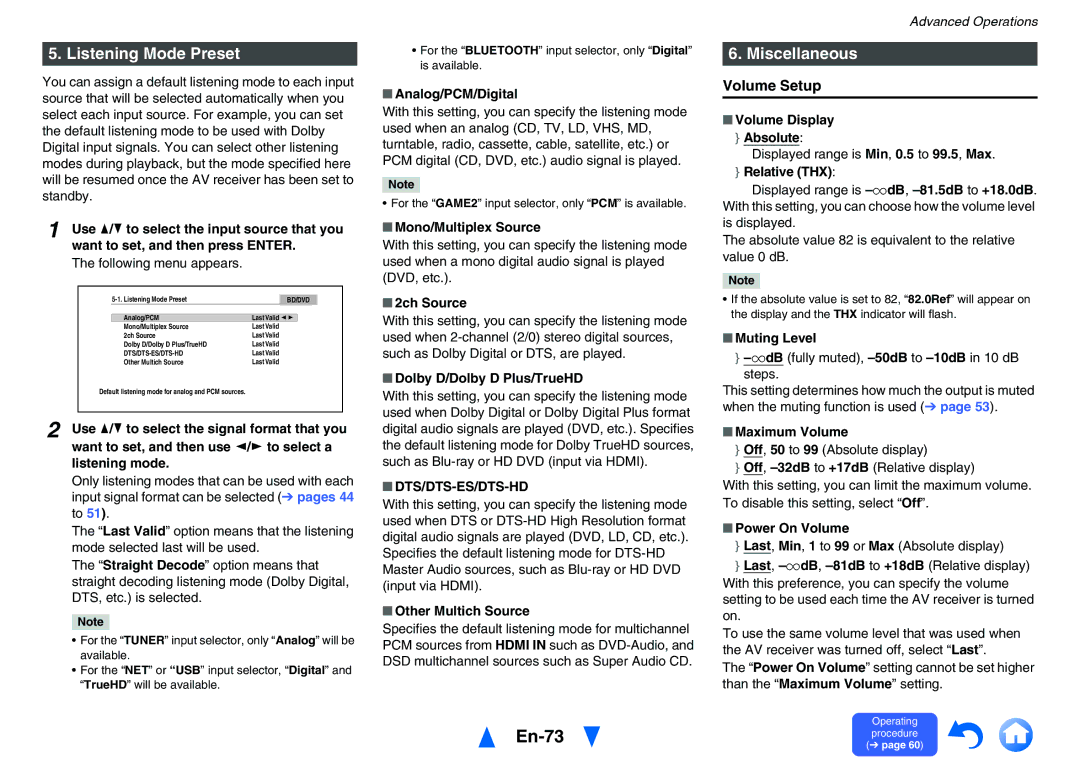
5. Listening Mode Preset
You can assign a default listening mode to each input source that will be selected automatically when you select each input source. For example, you can set the default listening mode to be used with Dolby Digital input signals. You can select other listening modes during playback, but the mode specified here will be resumed once the AV receiver has been set to standby.
1 Use q/wto select the input source that you want to set, and then press ENTER.
The following menu appears.
| BD/DVD | |
Analog/PCM | Last Valid e r | |
Mono/Multiplex Source | Last Valid | |
2ch Source | Last Valid | |
Dolby D/Dolby D Plus/TrueHD | Last Valid | |
| Last Valid | |
Other Multich Source | Last Valid | |
Default listening mode for analog and PCM sources.
2 Use q/wto select the signal format that you want to set, and then use e/rto select a listening mode.
Only listening modes that can be used with each input signal format can be selected (➔ pages 44 to 51).
The “Last Valid” option means that the listening mode selected last will be used.
The “Straight Decode” option means that straight decoding listening mode (Dolby Digital, DTS, etc.) is selected.
Note
•For the “TUNER” input selector, only “Analog” will be available.
•For the “NET” or “USB” input selector, “Digital” and “TrueHD” will be available.
•For the “BLUETOOTH” input selector, only “Digital” is available.
■Analog/PCM/Digital
With this setting, you can specify the listening mode used when an analog (CD, TV, LD, VHS, MD, turntable, radio, cassette, cable, satellite, etc.) or PCM digital (CD, DVD, etc.) audio signal is played.
Note
• For the “GAME2” input selector, only “PCM” is available.
■Mono/Multiplex Source
With this setting, you can specify the listening mode used when a mono digital audio signal is played (DVD, etc.).
■2ch Source
With this setting, you can specify the listening mode used when
■Dolby D/Dolby D Plus/TrueHD
With this setting, you can specify the listening mode used when Dolby Digital or Dolby Digital Plus format digital audio signals are played (DVD, etc.). Specifies the default listening mode for Dolby TrueHD sources, such as
■DTS/DTS-ES/DTS-HD
With this setting, you can specify the listening mode used when DTS or
■Other Multich Source
Specifies the default listening mode for multichannel PCM sources from HDMI IN such as
Advanced Operations
6. Miscellaneous
Volume Setup
■Volume Display
`Absolute:
Displayed range is Min, 0.5 to 99.5, Max.
`Relative (THX):
Displayed range is
The absolute value 82 is equivalent to the relative value 0 dB.
Note
•If the absolute value is set to 82, “82.0Ref” will appear on the display and the THX indicator will flash.
■Muting Level
`
This setting determines how much the output is muted when the muting function is used (➔ page 53).
■Maximum Volume
`Off, 50 to 99 (Absolute display)
`Off,
With this setting, you can limit the maximum volume. To disable this setting, select “Off”.
■Power On Volume
`Last, Min, 1 to 99 or Max (Absolute display)
`Last,
To use the same volume level that was used when the AV receiver was turned off, select “Last”.
The “Power On Volume” setting cannot be set higher than the “Maximum Volume” setting.
En-73
Operating procedure (➔ page 60)
